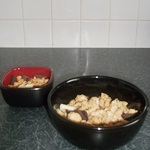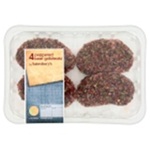How to lose weight by reducing portion size
There is a well-known saying that I remember hearing often as a child: “your eyes are bigger than your stomach.” This referred to the fact that the excitement of being confronted with favourite foods too easily lead to gluttony – and later on to a stomach ache after over-indulgence.
Habits learned in childhood are often carried into adulthood. Since I was a child, within my family all social activities revolve around food: birthdays, weddings, christenings, funerals, and even casual visits always seem to involve lots of delicious food!
On too many occasions I have gained weight through eating what my eyes desire, rather than what my stomach really needs and can handle. In recent years I have taken a more sensible approach to nutrition and eat a more balanced diet, but even then, eating a bigger portion size than is necessary is an easy way to pile on the calories without even realising it.
I have a couple of good examples to share. Take breakfast cereals. When I wasn’t following my Moderate Weight Loss Plan, I would often have a bowl of my favourite Triple Chocolate Cereal from Sainsbury’s, which the nutritional information on the box reveals is 261 calories for 50g with 100ml of milk.

Now I never used to weight my food, since I was convinced I could easily estimate what 50 grams of cereal would amount to. I assumed that it would be three quarters full of an average dessert bowl. And so I would eat my daily bowl of my favourite cereal feeling smug that I was eating a healthy diet.
The light bulb moment came last week when I devised my Moderate Weight Loss Plan, which would include my favourite cereal at weekends. I decided to weigh the cereal to confirm my earlier theory that 50 grams of it would fill one of my dessert bowls to the three quarter level.
I was shocked to find that the amount I had been eating in that bowl was 100 grams – double the amount I thought! So a breakfast I assumed was 261 calories was in fact 522 calories! The difference may not seem much, but over a period of four weeks eating this every day for breakfast, that could result in one extra pound of fat on your body – and over a year that amounts to almost one stone!
One of my favourite meals is a peppered beef grillsteak with a jacket potato and some vegetables on the side. As far as I was concerned, this was a healthy, balanced meal. But again, portion size can have a major impact on the amount of calories and fat in the steaks, as I discovered recently.
I used to eat the larger peppered beef grillsteaks like the ones sold in Asda in packs of two, weighting 170 grams and totalling 317 calories and 19.2 grams of fat. That was until I discovered that Sainsbury’s sells a pack of four of weighing half the amount at 85 grams and which is only 150 calories and 8.4 grams of fat.
After becoming accustomed to eating the larger steaks I was convinced the miniscule steaks from Sainsbury’s would not satisfy me. But I bought them anyway as an experiment, and to my

surprise found that they were just as filling as the ones I used to eat that were twice the size. Over time, eating larger portion sizes can lead to weight gain, even among people who eat a fairly balanced and healthy diet. This leads to claims of being “big boned” as a way if explaining the mysterious weight gain.
Weighing food might seem tedious, but usually you only have to weigh things once from the bowl or plate that you’ll be eating from to gauge how much the portion size is. And although our eyes are sometimes bigger than our stomachs, we can eat less than we desire and still be satisfied.
Reducing your portion size is a good approach to weight loss because it involves making a lifestyle change and is a long-term strategy for keeping weight off, permanently.















